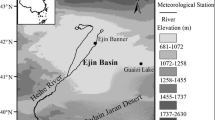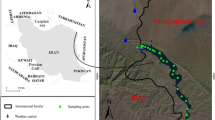Abstract
Pan coefficients have been developed for the Sukhna lake region in Chandigarh, India that has a humid tropical monsoon climate, using the optimisation technique for annual, monthly and seasonal time scales. Evaporation estimated using the Bowen ratio energy budget method has been considered as actual evaporation. Results show that the pan coefficient for the study area varies significantly both by month and season. The month-wise variation is in the range of 0.72–1.40 and the seasonal variation is in the range of 0.81–1.16. Pan coefficients obtained using various existing models such as Cuenca, Snyder, Modified Snyder, Pereira, Orang, FAO-56 and Wahed–Snyder have also been compared with the developed coefficients. Comparative analysis indicates that the pan coefficients obtained using the Snyder model overestimate evaporation significantly, while the rest of the models significantly underestimate evaporation. The study concludes that the developed pan coefficients are observed to estimate the open-water surface evaporation with a fair degree of accuracy for the study area while the pan coefficient value of 0.7 being used by most field organisations in India give high errors. However, since pan coefficients vary spatially due to the variation in the relative significance of various meteorological parameters, the pan coefficients developed in the present study need to be further evaluated for their suitability to other similar climatic regions of India.





Similar content being viewed by others
References
Abtew W 2001 Evaporation estimation for lake Okeechobee in south Florida; J. Irrig. Drain. Eng. 127 140–146.
Agnihotri Y, Bhattacharya P, Sharda V N and Tiwari A K 2006 Weather trends at Chandigarh; Central Soil and Water Conservation Research and Training Institute, Chandigarh Publication, Chandigarh.
Ali S, Ghish N C and Singh R 2008 Evaluating best evaporation estimate model for water surface evaporation in semi-arid region of India; Hydrol. Process. 22 1093–1106.
Allen R G, Pereira L S, Raes D and Smith M 1998 Crop evapotranspiration – Guidelines for computing cropwater requirements; FAO irrigation and drainage paper 56; FAO, Rome, pp. 144–146.
Alvarez V M, Gonzalez-Real M M, Baile A and Martinez M 2007 A novel approach for estimating the pan coefficient of irrigation water reservoirs: Application to South Spain; Agric. Water Manag. 92 29–40.
Assouline S and Mahrer Y 1993 Evaporation from lake Kineret 1. Eddy correlation system managements and energy budget estimate; Water Resour. Res. 29(4) 901–910.
Bowen I S 1926 The ratio of heat losses by conduction and by evaporation from any water surface; Phys. Rev. 27 779–787.
Chiew F H S, Kamaladasa N N, Malano H M and McMahon T A 1995 Penman–Monteith, FAO-24 reference crop evapotranspiration and class-A pan data in Australia; Agric. Water Manag. 28 9–21.
Cuenca R H 1989 Irrigation system design: An engineering approach; Prentice Hall, Englewood Cliffs, NJ.
de Bruin H A R 1982 Temperature and energy balance of a water reservoir determined from standard weather data of a land station; J. Hydrol. 59 261–274.
Dingman S L 1994 Evapotranspiration; In: Physical hydrology (ed.) Robert McConnin, McMillan Publ. Co., New York, pp. 256–265.
Duan Z and Bastiaanssen W G M 2017 Evaluation of three energy balance-based evaporation models for estimating monthly evaporation for five lakes using derived heat storage changes from a hysteresis model; Environ. Res. Lett. 12(2) 2–13.
Finch J W and Hall R L 2001 Estimation of open water evaporation – a review of methods; R&D Technical Report W6-043/TR, Environment Agency, Rio House, Waterside Drive, Aztec West, Almondsbury, Bristol.
Fu G, Liu C, Chen S and Hong J 2004 Investigating the conversion coefficients for free water surface evaporation of different evaporation pans; Hydrol. Process. 18 2247–2262.
Grewal S S 2009 Study on impact of soil conservation measures in the catchment of Sukhna lake on ground water, soil and geology; Project Report of the Society for Promotion and Conservation of Environment (SPACE), submitted to the Department of Forests and wildlife, Chandigarh, India.
Gunaji N N 1968 Evaporation investigations at Elephant Butte Reservoir in New Mexico; Int. Assoc. Sci. Hydrol. 78 308–325.
Gundekar H G, Khodke U M, Sarkar S and Rai R K 2008 Evaluation of pan coefficient for reference crop evapotranspiration for semi-arid region; Irrig. Sci. 26(2) 169–175.
Harbeck G E 1954 Water loss investigations: Lake Hefner studies; US Geological Survey Professional Paper, No. (269), pp. 1–157.
Harbeck G E J, Kohler M A and Koberg G E 1958 Water-loss investigations: Lake Mead studies; Professional Paper 298, US Geological Survey, pp. 1–99.
Heydari M M and Heydari M 2014 Evaluation of pan coefficient equations for estimating reference crop evapotranspiration in the arid region; Arch. Agron. Soil Sci. 60(5) 715–731.
Ikebughi S, Seki M and Ohtoh A 1988 Evaporation from lake Biwa; J. Hydrol. 102 427–429.
Irmak S, Haman D Z and Jones J W 2002 Evaluation of Class-A pan coefficients for estimating reference evapotranspiration in humid location; J. Irrig. Drain. Eng. 128 153–159.
Jensen M E 2010 Estimating evaporation from water surfaces; Presented at theCSU/ARS evapotranspiration workshop, Fort Collins, CO, 15 March, 2010.
Jensen M E, Burman R D and Allen R G 1990 Evapotranspiration and irrigation water requirements; Technical Report 70, American Society of Civil Engineers, New York.
Khobragade S, Semwal P, Kumar C P, Kumar S, Jain C K and Singh R D 2013 Integrated hydrological investigations on Sukhna Lake, Chandigarh for its conservation and management; Draft Final Report of the Consultancy Project submitted to Chandigarh Administration.
Koberg G E 1964 Methods to compute long-wave radiation from the atmosphere and reflected solar radiation from a water surface; Professional Paper 272-F, US Geological Survey, pp. 107–136.
Lenters J D, Kratz T K and Bowser C J 2005 Effects of climate variability on lake evaporation: Results from a long-term energy budget study of Sparkling Lake, northern Wisconsin (USA); J. Hydrol. 308 168–195.
Linacre E T 1994 Estimating U.S. Class A pan evaporation from few climate data; Water Int. 19 5–14.
Linsley R K, Kohler M A and Paulhus J L H 1975 Evaporation and transpiration; In: Hydrology for engineers (eds) Ven Te Chow, Eliassen R and Linsley R K, McGraw-Hill Intl. Book Co., New Delhi, pp. 139–143.
McJannet D L, Cook F J and Burn S 2013 Comparison of techniques for estimating evaporation from irrigation water storage; Water Resour. Res. 49 1415–1428.
Mohammadi M, Ghahraman B, Davary K, Liaghat A M and Bannayan M 2012 Pan coefficient (\(K_{\rm p}\)) estimation under uncertainty on fetch; Meteorol. Atmos. Phys. 117 73–83.
Nordenson T J 1963 Appraisal of seasonal variation in pan coefficients; Int. Assoc. Sci. Hydrol. 67 279–286.
Orang M 1998 Potential accuracy of the popular non-linear regression equations for estimating Pan coefficient values in the original and FAO-24 tables; Unpublished California Department of Water Resources Report, Sacramento, Calif.
Pereira A R, Villanova N, Pereira A S and Barbieri V A 1995 A model for the Class-A pan coefficient; Agric. Water Manag. 76 75–82.
Pradhan S, Sehgal V K, Das D K, Bandyopadhyay K K and Singh R 2013 Evaluation of pan coefficient methods for estimating FAO-56 reference crop evapotranspiration in a semi-arid environment; J. Agrometeorol. 15(I) 90–93.
Rahimikhoob A 2009 An evaluation of common pan coefficient equations to estimate reference evapotranspiration in a subtropical climate (north of Iran); Irrig. Sci. 27 289–296.
Rosenberry D O, Winter T C, Buso C D and Likens G E 2007 Comparison of 15 evaporation methods applied to a small mountain lake in the northeastern USA; J. Hydrol. 340 149–166.
Sabziparvar A A, Tabari H, Aeini A and Ghafouri M 2010 Evaluation of Class A pan coefficient models for estimation of reference crop evapotranspiration in cold semi-arid and warm arid climates; Water Res. Manag. 24 909–920.
Semwal P, Khobragade S, Kumar C P and Singh R D 2013 Inventory of silt detention dams in the catchment of Sukhna Lake, Chandigarh; In: Proceedings of the national conference on ‘Clean Water & Health’ organized by IDC Foundation, Delhi, 5–6 April, 2013.
Shuttleworth W J 1993 Evapotranspiration; In: Handbook of hydrology (ed.) Maidment D R, McGraw-Hill, Inc., New York, USA.
Simon E and Mero F 1985 A simplified procedure for the evaluation of the lake Kinneret evaporation; J. Hydrol. 78 291–304.
Snyder R L 1992 Equation for evaporation pan to evapotranspiration conversions; J. Irrig. Drain. Eng. 118(6) 977–980.
Stannard D and Rosebarry R 1991 A comparison of short term measurement of lake evaporation using eddy-correlation and energy budget method; J. Hydrol. 122 15–22.
Sturrock A M, Winter T C and Rosenberry D O 1992 Energy budget evaporation from Williams lake: A closed lake in north central Minnesota; Water Resour. Res. 28(6) 1605–1617.
Sweers H E 1976 A nomogram to estimate the heat-exchange coefficient at the air-water interface as a function of wind speed and temperature; A critical survey of some literature; J. Hydrol. 30 375–401.
Tabari H, Mark E and Trajkovic S 2011 Comparative analysis of 31 reference evapotranspiration methods under humid conditions; Irrig. Sci. 31(2) 107–117.
Trajkovic S and Kolakovic S 2010 Comparison of simplified pan-based equations for estimating reference evapotranspiration; J. Irrig. Drain. Eng. 136 137–140.
Turbak A S and Muttair F F 1994 Pan coefficients with Penman approach with different vapour pressure deficits; J. King Abdulaziz Univ. Metrol. Environ. Arid Land Agric. Sci. 5 61–75.
Wahed M H A and Snyder R L 2008 Simple equation to estimate reference evapotranspiration from evaporation pans surrounded by fallow soil; J. Irrig. Drain. Eng. 134(4) 425–429.
Winter T C 1981 Uncertainties in estimating the water balance of lakes; Water Res. Bull. 17(1) 82–112.
Winter T C, Rosenberry D O and Sturrock A M 1995 Evaluation of 11 equations for determining evaporation for a small lake in North Central United States; Water Resour. Res. 31(4) 983–993.
WMO (World Meteorological Organization) 1966 Measurement and estimation of evaporation and evapotranspiration; Technical Note No. 83, WMO-No. 201. TP.105, Geneva.
Acknowledgements
The authors are thankful to Department of Forests and Wildlife, Chandigarh, for the logistic support towards the generation of the data required for the study.
Author information
Authors and Affiliations
Corresponding author
Additional information
Corresponding Editor: Kavirajan Rajendran
Rights and permissions
About this article
Cite this article
Khobragade, S.D., Semwal, P., Senthil Kumar, A.R. et al. Pan coefficients for estimating open-water surface evaporation for a humid tropical monsoon climate region in India. J Earth Syst Sci 128, 175 (2019). https://doi.org/10.1007/s12040-019-1198-2
Received:
Revised:
Accepted:
Published:
DOI: https://doi.org/10.1007/s12040-019-1198-2




